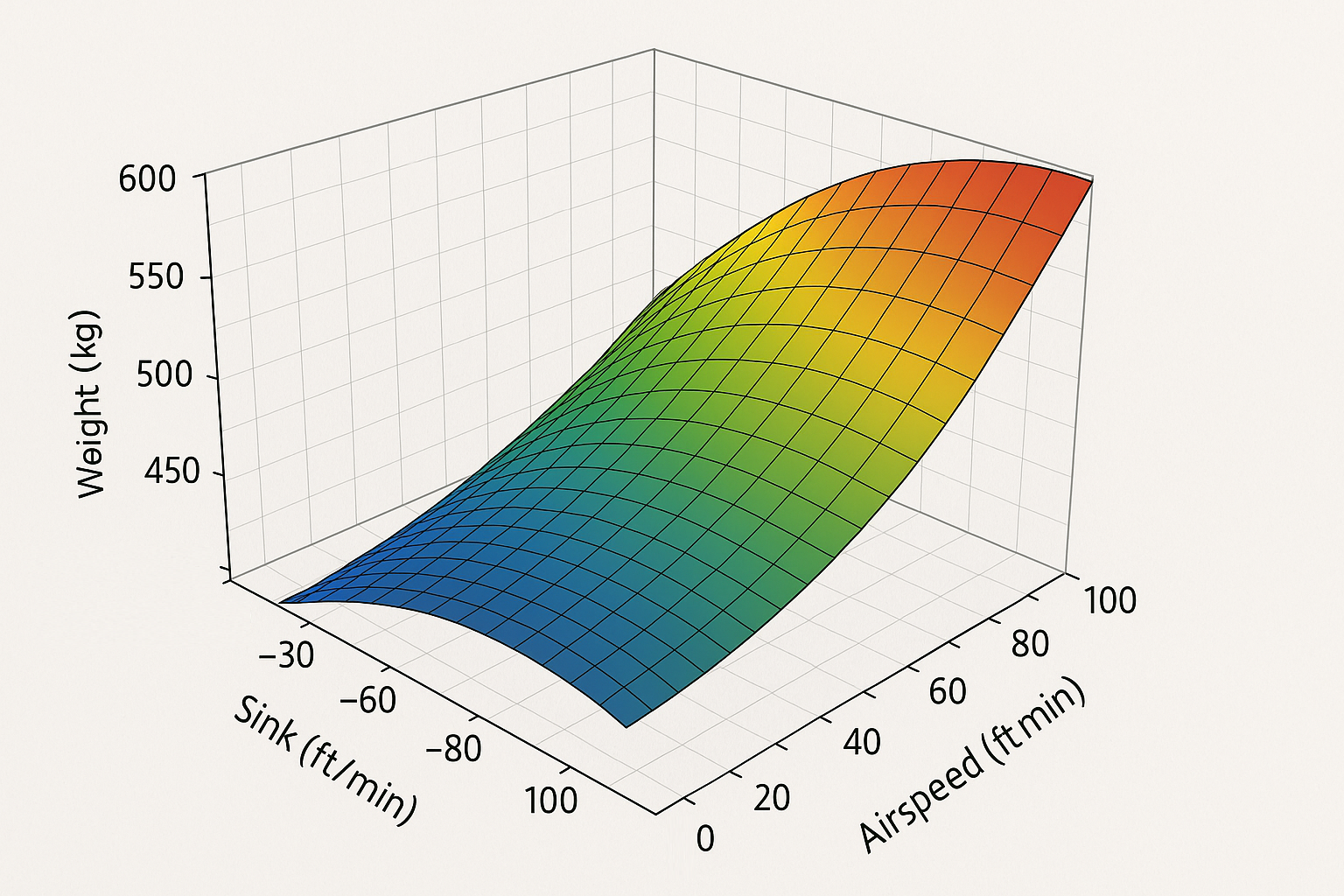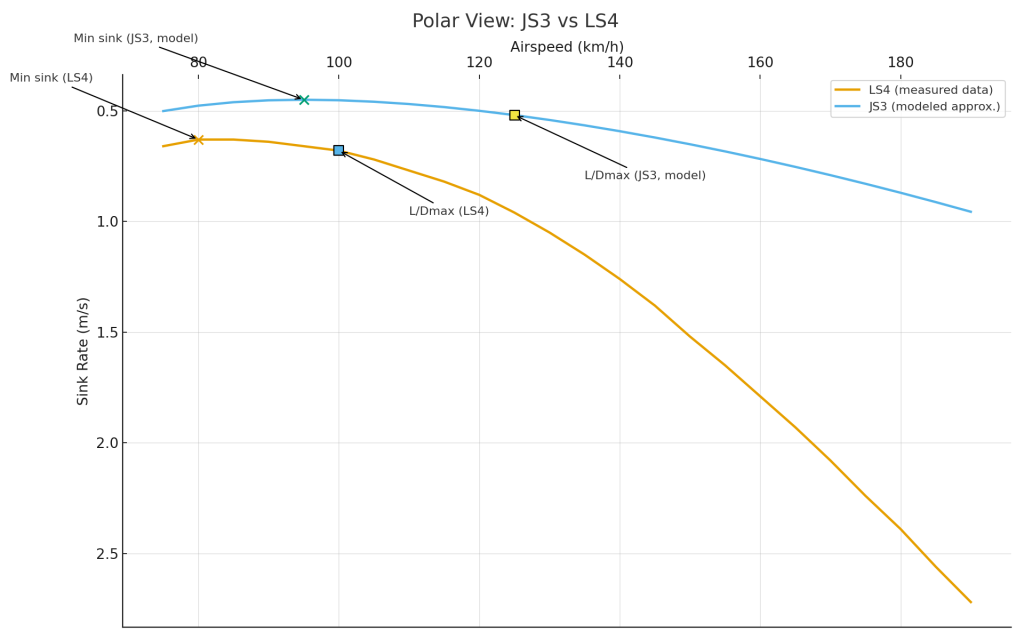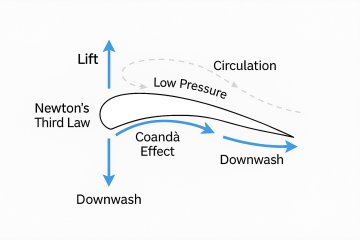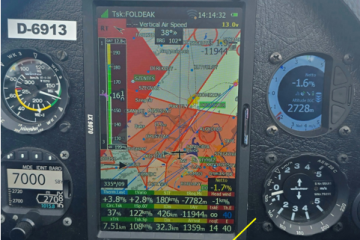
Reading the Polar Curve Like a Pro
What your glider’s polar really tells you — and what it doesn’t.
Introduction: More Than Just a Curve
Ask any glider pilot what their aircraft’s polar curve looks like, and most will proudly point to the sleek downward swoop ending somewhere around a 40:1 glide ratio. But the truth is, the polar isn’t just a manufacturer’s brag sheet — it’s a living, breathing portrait of how your glider trades energy for distance. Understanding it deeply changes how you fly, how you ballast, and even how you think about weather and task speed.
At OhMyGlider, we like to say: “Once you can read the polar, you can read the sky.”
1. What the Polar Curve Really Represents
A glider’s polar curve plots sink rate (vertical axis) against airspeed (horizontal axis).
Every point along that line is a snapshot of how much altitude you lose while flying at a given speed in still air. The lower the curve, the better the performance — meaning you can fly faster with less sink. However, the polar is more than a static graph. It encodes three fundamental truths:
- Your minimum sink speed: where the curve is lowest.
- Your best glide ratio: the tangent from the origin to the curve — that’s your L/Dmax point.
- Your energy trade-off: how much altitude you spend to go faster.
For instance, the LS4 has its best L/D (~40:1) at around 90 km/h, whereas a JS3 reaches ~55:1 at 110 km/h. That difference defines not just speed — but how aggressively each glider can “cut through” airmass variations.

2. Why Real-Life Polars Are Never Factory Polars
The glossy brochure polar is a dream world:
- flown in calm, dry air
- with a perfectly clean wing
- at exactly the certified weight
- and usually by a test pilot who knows the aircraft’s every nuance.
In real life, your polar is a moving target. Add a few dead bugs, a slightly imperfect seal, or 50 litres of water ballast — and your curve shifts upward and sideways.
Example:
An LS8-18 at 500 kg will achieve around 44:1, but at 600 kg with ballast, its minimum sink worsens while the optimum speed moves up by roughly 10–15 km/h. That’s not a flaw — that’s physics. Heavier aircraft penetrate better, climb worse, and reward you with higher cruise speeds between thermals.
The key lesson: every change you make in the cockpit moves your polar.
3. The Real Art: Matching Polar to the Sky
A polar curve on paper means nothing until it meets the atmosphere. Thermals, wind, and convection distort the “perfect still-air world” that the polar assumes. So your job as a pilot is to mentally deform that curve to fit real conditions.
3.1. Strong-Day Mindset
When thermals are booming (say +4 m/s average), flying at the best L/D speed is a mistake. You’re wasting time floating around too slowly between thermals. This is where MacCready theory comes in — tilting the tangent line upward to represent expected climb rate. The steeper the tangent, the faster the optimum cruise.
For example:
- On a good day, an LS8 with a MacCready setting of 3 will cruise closer to 130 km/h.
- The same day, a JS3 might push 150 km/h or more with comparable glide efficiency.
3.2. Weak-Day Patience
In weak, blue conditions (+1.5 m/s or less), your polar discipline matters more than ever. Even a 0.2 m/s misjudgment in average sink can mean losing 100 meters over a 10 km glide. That’s the difference between arriving above or below final glide height.
Pro tip: Always “fly the average” — not the spike. Watch your vario trend, not the instantaneous peaks.
4. How to Actually Read and Use Your Polar in Flight
4.1. The Straight Glide
Let’s say you’re in your LS4 at 95 km/h, cruising toward the next cumulus. You know from your polar that your still-air sink rate is ~0.6 m/s. But your vario shows −1.2 m/s — that means you’re in slightly sinking air (~0.6 m/s of it). If your MacCready is set to 1.5, your optimal speed might now be 110 km/h.
The beauty of the polar is that it makes this adjustment predictable — not guesswork.
4.2. Energy Height and the Polar
A subtle yet crucial concept: total energy height (TEH). Your polar curve doesn’t just represent airspeed vs. sink, but how potential and kinetic energy exchange. If you pull up slightly, you’re trading speed for altitude; if you push down, the opposite. That movement along the curve is what the variometer measures — a combination of your sink and pitch energy. When you learn to feel those transitions, you stop chasing the needle and start flying the curve.
5. Ballast: Shifting the Polar with Purpose
Adding ballast increases wing loading, which reshapes the polar curve:
- Shift right: higher speeds for same sink rate
- Shift up: higher minimum sink rate
Imagine overlaying two curves — one for an unballasted LS8, one for a full JS3 with 180 l ballast. The JS3’s curve will sit higher but extend further to the right — a high-speed specialist. This is why experienced pilots don’t ask “Should I ballast?” They ask, “Is today fast enough to justify it?”
A good rule of thumb:
- Weak day: light, thermalling efficiency rules.
- Strong, cumulus day: ballast, go fast, stay high.
In competitions, JS3 pilots often ballast fully even in moderate conditions — because their polar’s slope remains favourable at high MacCready values.
6. From Chart to Cockpit: Practical Steps
6.1. Learn Your Numbers
You don’t need the full factory sheet memorized — just the key benchmarks:
- Min sink speed
- Best L/D speed
- MacCready-adjusted cruise speeds (for MC = 1, 2, 3, 4)
Stick a small chart on your panel, or use your LXNAV or Oudie to auto-display the MacCready line on-screen.
6.2. Validate Your Polar
Use your own flight data to verify how your glider performs.
- Fly straight legs at steady speed (no thermals).
- Record average sink over 30–60 seconds.
- Compare to the factory curve.
You’ll be surprised how much your real-world polar differs — especially if your seals or pitot calibration aren’t perfect.
6.3. Don’t Forget the Bugs
Even a thin film of insect residue on the leading edge can raise sink by 0.1–0.2 m/s. That’s huge at 100 km/h. Keep your wings clean, and your polar will thank you.
7. Polar Psychology: The Human Factor
Pilots rarely underperform because their glider is bad — they underperform because they misread what the glider is trying to tell them. Every polar point reflects a decision about risk, time, and lift expectations.
- Flying too fast = pessimistic about lift.
- Flying too slow = overly hopeful.
- Flying at the right speed = confident, data-driven.
Your polar teaches you emotional discipline: to trust physics over feeling.
8. Example Comparison: LS4 vs. LS8 vs. JS3
Let’s make the polar personal.
| Glider | Class | Best Glide | Speed (L/Dmax) | Typical Cruise (MC=2) | Notes |
|---|---|---|---|---|---|
| LS4 | Club Class | ~40:1 | 90 km/h | ~115 km/h | forgiving, gentle, great in weak lift |
| LS8-18 | Standard/18m | ~44:1 | 100 km/h | ~130 km/h | adaptable, good balance of climb vs. cruise |
| JS3 | 18m/Open | ~55:1 | 110 km/h | ~150 km/h | world-class performer, heavy ballast capacity |
This table tells a story. The JS3 may be king at high speeds, but in a soft blue-thermal day, an LS4 pilot can still outperform it by climbing tighter and lighter. Reading the polar helps you fly your glider on its terms — not someone else’s.
9. Visualizing the Polar in 3D
Most pilots think of the polar as a flat 2D chart. But in reality, it’s a 3D surface — with the third axis being weight or wing loading. As you add ballast, the whole surface twists upward and rightward. Modern flight computers (like LX9000 or Naviter Oudie N) can show this dynamically, adjusting your MacCready line in real time as your weight changes due to ballast dump or fuel burn (in self-launchers). Understanding this three-dimensional aspect is the next level of mastery — you start predicting how your aircraft will evolve through the flight.

10. Bringing It All Together
To “read the polar like a pro” means:
- Knowing your glider’s real-world polar — not just the factory curve.
- Constantly adjusting it in your head for weather, ballast, and air mass.
- Using MacCready not as a setting, but as a conversation between you and the sky.
Once you internalize these principles, the polar stops being a graph — and becomes a sixth sense. You’ll start to feel when you’re below the line, when the air isn’t supporting your expectations, and when it’s time to speed up or slow down. That’s when you’ve truly learned to read the polar.
Conclusion: The Curve That Teaches Confidence
The beauty of gliding is that no instrument can fully replace intuition — but the polar curve comes closest. It’s the quiet mentor in your cockpit, whispering through the variometer needle: “You know what the air is doing. Now act accordingly.”
So next time you’re between thermals, take a moment to think of that elegant curve —
and remember, it’s not just about numbers. It’s about reading the sky through your wings.




































